Pipes
The organ has a total of 247 pipes.
Mostly
in wood, but 25 counter melody clarinets are in brass. In the table
below the
MIDI
columns 'Reg' and 'Note' is the respective note numbers used for
control.
'Sound' refers to what pitch is actually produced by the pipes. The
counter
melody pipes sound 4 octaves higher than their control codes, they are
-48
semitone steps transposed in the MIDI score. The chimes note controls
are transposed +29
steps.
| Chest |
MIDI |
L/W(69) |
Pipe
type |
| Reg. |
Note |
Sound |
| 8 *
Bass
(G A #A B C D E F)
|
0 |
43-54 |
43-54 |
12
|
open
flue, detuners
|
| 1 |
31-41 |
12
|
cyl. reed |
| 12 *
Accompaniment
(G .. F+)
|
2 |
55-66 |
55-66 |
24
|
open flue cello
|
| 3 |
55-66 |
12
|
open flue |
| 4 |
43-54 |
12
|
cyl. reed |
| 25 * Counter
melody
(C .. C)
|
5 |
12-36 |
60-84 |
12
|
open flue |
| 6 |
72-96 |
24
|
open flue
violin |
| 7 |
60-84 |
17
|
reed
clarinets |
| 30 *
Melody
(G .. C)
|
8 |
67-96 |
55-84 |
12
|
stoppered
flue |
| 9 |
67-96 |
9
|
flared trumpet |
| 10 |
67-96
|
12
|
open
flue |
| 11 |
67-96 |
24
|
open flue violin |
| 20 * Chimes
(C-G) |
- |
101-120 |
72-91 |
|
tuning forks w. resonators |
| Tremulant on |
39 |
|
|
|
|
| Reg. cancel |
40 |
|
|
|
|
Bass chest
Reg 0: Open flue pipes
|
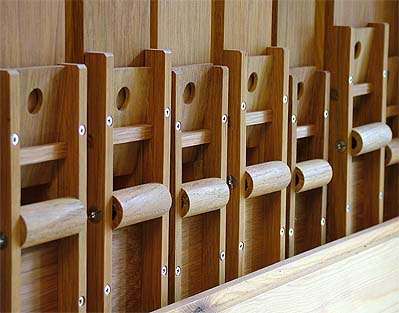
|
An initial
set of stoppered basses turned out a
little too meek.
Having
now
finalized the height of the cabinet to be more than planned when I
first
made those pipes long ago, I made a new set, this time
open pipes with the same diameters (51..71 mm, 2..3 in). Only the two
lowest
ones, for G (1.75 m long) and A had to be mitered.
The body of them is made from 7 mm pine
plywood except the front
that
is oak. In respect of their size I made good use of a table saw and a
shoulder
plane to make the long joints with grooves and tongues. Some extra work
that pays off when it comes to gluing. First back and sides, with the
front
loosely in place to keep the sides parallel. Next round, after fine
trimming
the two bottom blocks are glued and, having clamped those, the front. |
| The mouth
design like shown, gives a
fairly large degree of freedom
in voicing. A number of loose pieces, in particular a little bar f,
resting in notches in the ears e, to hold down the adjustable
upper
lip a with an elastic leather gasket in between. Nothing is
glued
here, all is held together by the slim screws through the ears into the
sides of the body, plus a crosswise threaded bolt with nuts through the
intonation roll d. The roll has a big hole in it to allow for
fine
adjustment of its position. So far I have always found the lowest point
of the roll should be on the plane of the languid, the adjustment to be
done is the distance to the flue jet. Perhaps the least elegant
adjustment
is for how the jet hits the labium - can be modified with shims between
a
and b unless you do some carving in b or remake a.
The round hole in it is a pull-out handle, decoration, and trigger for
people to ask what for. |
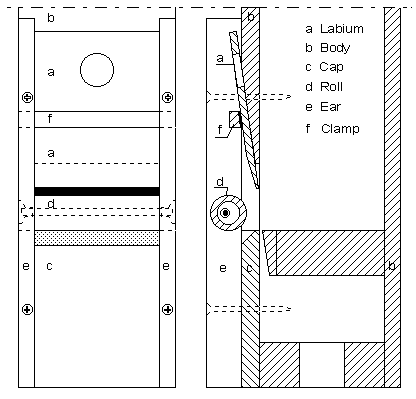 |
|
These pipes have tuning sliders
at their top end, somewhat
more
elaborate than with the smaller pipes. They are made from brass sheet.
Inside the pipe, each side of the tuning slot, is an oak stick with a
threaded hole, held by a locking screw. Tightening these screws presses
the
slider firmly against the inside of the pipe front.
Four of these eight pipes are equipped with detuners, such that the rank implements a fully
chromatic octave.
|
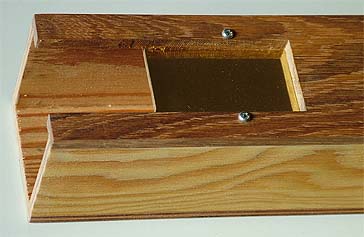 |
Reg 1: Bass reed pipes
 |
These are
the lowest bass pipes,
cylindrical 'bass clarinets', one quarter
wavelength. Also this rank replaces an initial one, namely conical
trombones. These clarinets are somewhat
longer
than the trombones, but they speak one octave lower. Since the boot has
a rather small volume it is fitted with a spring loaded diaphragm to
make
a 'schwimmer'. This acts to reduce the AC pressure variations inside
the
boot
and is good to ease voicing and to stabilize reed oscillation.
The boots of these pipes have little flags, strips of motor cloth,
fixed with screws at the top ends, and marked with white dots at the
low free ends. Behind each flag is a small hole such that when the pipe
is blown the flag swings out to visualize that the pipe is on.
|
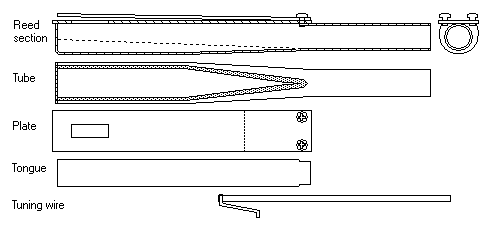 |
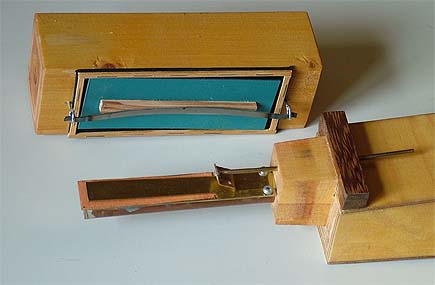 |
|
The shallots are made from copper
pipe, slotted and with
a
brass
cover plate soldered on. This plate has a hole extending under part of
the tongue and is covered with glued on pouch leather. The tongues are
brass,1.2 to 1.5 mm thick, held by a
pair of
screws threaded into the shallot plate.
|
Accompaniment chest
Reg 2: Accompaniment cello pipes
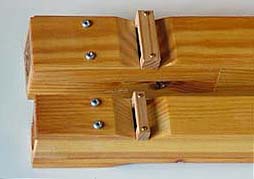 This is a set of
narrow
violin-type pipes that are a continuation downward from the melody
violins. The design is shown at the section of the countermelody
violins, register 6.
This is a set of
narrow
violin-type pipes that are a continuation downward from the melody
violins. The design is shown at the section of the countermelody
violins, register 6.
Reg 3: Accompaniment principals
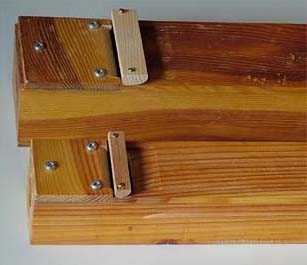 |
These pipes form a link between
the bass (reg 0) and melody (reg 10) flutes having the same scale.
Bridges have been added later to allow for wider flues and more power
without overblowing. On the chest this rank is placed between the
cellos (reg 2) and the reeds (reg 4) such that nobody can see those
ugly bridges.
|
Reg 4: Accompaniment reed pipes
 |
The
resonators of these are a continuation upward of the bass reed pipes,
speaking one octave below the other ranks on the accompaniment chest.
The shallots and boots are inherited from an earlier, but discarded
rank of conical pipes.
The resonator front plate is bent slightly inwards in the lowest part,
in order to give room for the tuning wire.
The jack mechanism to adjust the tuning wires with a screwdriver is no
good invention. It is rather easier to tune them the conventional way
knocking the wires.
|
Counter melody chest
Reg 5: Counter melody flutes
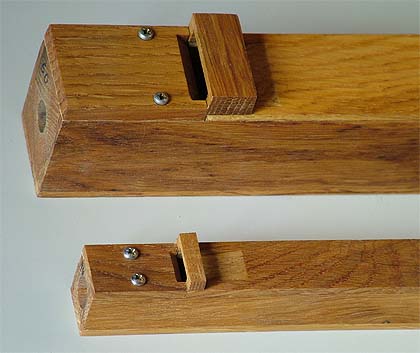 |
Made from
oak slabs, recovered
from an old parquet floor.
They are deeper than wide by a ratio of 4:3. This is the only rank
(except the trumpets) where the cross section deviates from square.
Bridges cover the entire mouth area. These features allows the airband
to be quite thick without overblowing, so these pipes are
comparatively loud. |
Reg 6: Counter melody violin pipes
This rank is made identically like the melody violins, register 11.
 |
These very skinny pipes are
made from recycled old fir. The resonators of the dozen smallest pipes
are formed as a milled grooves in integral back pieces, covered by
front plates, chamfered for the labium. The bigger pipes are assembled
conventionally from four plates plus a bottom block.
The cut up is fairly low and they are vigorously blown. To prevent
overblowing the height of the bridges was carefully adjusted in the
same time as the flue width was made as large as possible.
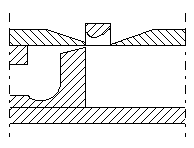 The
inner surface of the bridges is intuitively streamline shaped. The
chamfering of the covers is essential to let air be entrained with the
jet. The sound from these pipes is amazingly loud and penetrating,
regarding the minute size of the openings in the mouth region. |
Reg 7: Counter melody reed clarinets
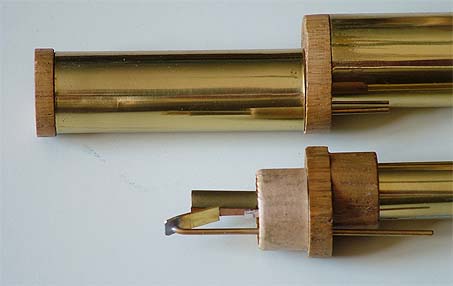 |
The
central
head piece, made from oak, has upper and lower cylindrical surfaces
with
offset
axes. This offset gives room for the tuning wire running parallel to
the
tubes. The resonator tube and the boot are both
plainly
cylindrical. Nominal 1/4 wavelengths are quite close to
the
actual lengths of the resonator tubes. Diameters range from 29 to 17
mm,
halving number about 24.
The
tubes are made from standard half hard 0.2 mm brass sheet. This is much
springier
than pipe tin alloy, makes it difficult to shape them, but has a good
tensile
strength such that I can have such a thin wall and save a lot of
weight.
The tools to shape them was a set of cylindrical oak dowels, diameters
29,
25, 22, 19, 17, 15, 13 mm. I used only these
listed
diameters, about 5 pipes each size, no need to make individually
interpolated
diameters. |
Melody chest
Reg 8: Melody stoppered pipes
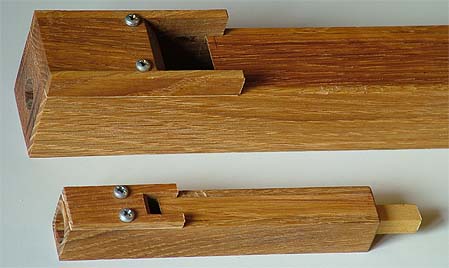 |
This rank
was built with the same basic design and measures as the open flutes
below (reg 10). Because they are stoppered they however speak one
octave lower, and this calls for a higher cut up, other parameters
constant.
|
Reg 9: Melody reed trumpets
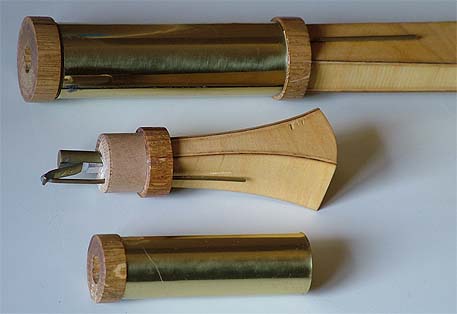
| MIDI |
Note |
Freq |
Wavel |
Lh
mm |
Wm
mm |
| 69 |
a' |
440 |
780 |
273 |
39,0
|
For the other pipes lengths are
proportional to the inverse of frequency, and diameters to the square
root of that.
|
For the
shape of these resonators I arbitrarily decided on the area function A=Ao*exp(3*x2),
where Ao is the
throat area and x is the relative length coordinate along
the horn, from 0 to 1. This is not a common exponential horn because
the x
argument is squared. This means the flare is moderate in the throat and
much more drastic toward the mouth, an expedient to make it a little
more trumpet-like. There is a factor 3 for the argument,
meaning that the mouth area will be exp(3)=20 times larger than the
throat area. On top of this I prescribed that both the throat and the
mouth are to be squares. Mouth diameter is then about sqrt(20)=4.5
times throat diameter.
This defines the relative shape of the resonators. After making a
prototype I found the length of the resonators should be 0.35
wavelength. Skinniness was arbitrarily selected to L/W(69)=10
(half wavelength/mouth diameter for reference note a') and the halving
number M=24. This results in
horn length Lh
and mouth diameter Wm
for the a' pipe as shown beside. |
Two opposing sides of the horn are straight edge trapezoids, bent into
shape. The other two are flat but with edges that are intricately
curved to make up the desired area function. All sides are made from 4
mm birch plywood, made from three layers of veneer. The pieces were
oriented such that the middle layer grain goes along the pipe, the
visible layers across. Unless you orient them that way you cannot bend
the trapezoidal sides without breaking them.
| To make the
curved side pieces I started from this drawing (blue contours), as
computed
from the formula above, respecting contribution from the trapezoidal
shape of the companion sides (red contours). The cross section of the
horn at half its
length is a quite oblong rectangle. Next step was to make copies of the
drawing, one for each pipe, appropriately scaled lengthwise and cross
wise. These were glued to the plywood stock, laid in two layers, and
served as templates for cutting out the blanks. |
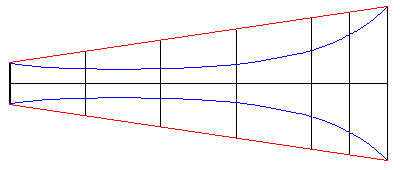 |
The trapezoidal pieces were made with
extra width to account for the thickness of the side pieces plus a
margin for trimming. Then made shoulders on their long sides with a
shoulder plane, such that the remains met the required internal width
measures. I took away only the innermost veneer and its glue layer,
about 1.3 mm. The curved pieces were accurately trimmed. Width plus
twice the
shoulder depth was checked with a caliper against a big table produced
with an Excel sheet. Pieces were always held pairwise together in a
vise.

The
horns were glued with plain white glue to give enough time to
adjust the pieces accurately while clamping. The positioning and
clamping of the four horn pieces is critical. I found the special jig
visible beside to be indispensable for the task. It is two square
angles that are adjustably held together by screws with wing nuts.
Before the gluing operation they are set to contain a rectangle
matching the horn about 1/12 of its length from the mouth. When glue
has been applied to the shoulders of the trapezoidal pieces you
assemble the four pieces in your hand, let on the squares jig, and
clamp the throat temporarily. Then you have to press the jig firmly in
direction toward the mouth. Once the jig is in place you can clamp the
rest of the
horn easily, observing to push the side pieces all the way onto the
shoulders.
After trimming the outside a number of oak pieces were glued outside
the throat, which was also plugged to a depth of 20 mm to later accept
a hole for the shallot. The head was then shaped in the lathe.
Reg 10: Melody flutes
These are made from oak slabs
recycled from a parquet floor. It is the first complete rank I built
for this organ after exporing the subject of flue dimensioning. The
design follows my original MMD article
Recipe
for
Wooden Organ Flue Pipes which includes dimensioning formulas
and their implementation in an Excel spreadsheet. The same design
and basic dimensions was used for the stoppered pipes, reg 8.
 |
Except the
highest pipes most are equipped with intonation rollers between the
ears to prevent overblowing. The precise position of a roller has to be
tried out during voicing operations.
After cutting a small recess in the cover, the inside of the cover and
the outside of the body are ground flat. One idea with this design was
that it might make it easy to control the flue slit by selecting and
perhaps grinding down the thickness of the gasket. Later experiences
tended to show it is easier to file down the languid, so that is what I
did for most of the other flue ranks.
|
Reg 11: Melody violin pipes
This rank is made identically like the countermelody violins, register
6, only it has five more pipes extending downward.
Surface finish
Brass sheet details are polished with a buffing wheel and paste. Then
coated with clear lacquer to avoid fingerprints which cause ugly
oxidizing marks.
After being glued together, but before voicing, all wooden pipes are
internally sealed off with
thin hot hide glue. Starting with the biggest pipe in a rank, tape over
its mouth and fill it with glue for some 20 seconds, then pour the glue
back into the pan. Remove the tape and let the pipe dry upside down on
a newspaper. This will close pores and small voids and leave a hard and
airtight interior surface.
Externally pipes as well as most carpentry is painted with boiled
linseed oil.
Dimensions table
For reference, here is an expanded
table, also linking the MIDI note
numbers n
(0<n<127) to the
conventional note names (A .. #G),
and the fundamental frequencies f
(pitches) of these notes in Hz. Only
the span covered in the organ is shown. The
underlying basis is the equally tempered scale and that standard pitch
is a'=440 Hz, MIDI note
number 69. The table thus shows the fundamental
frequency as defined by
the formula f = 440 * 2
(n-69)/12
The table also highlights the continuity of scaling across
the
different chests. For instance that the flutes of the bass,
accompaniment, and melody chests essentially form a coherent principal
rank.
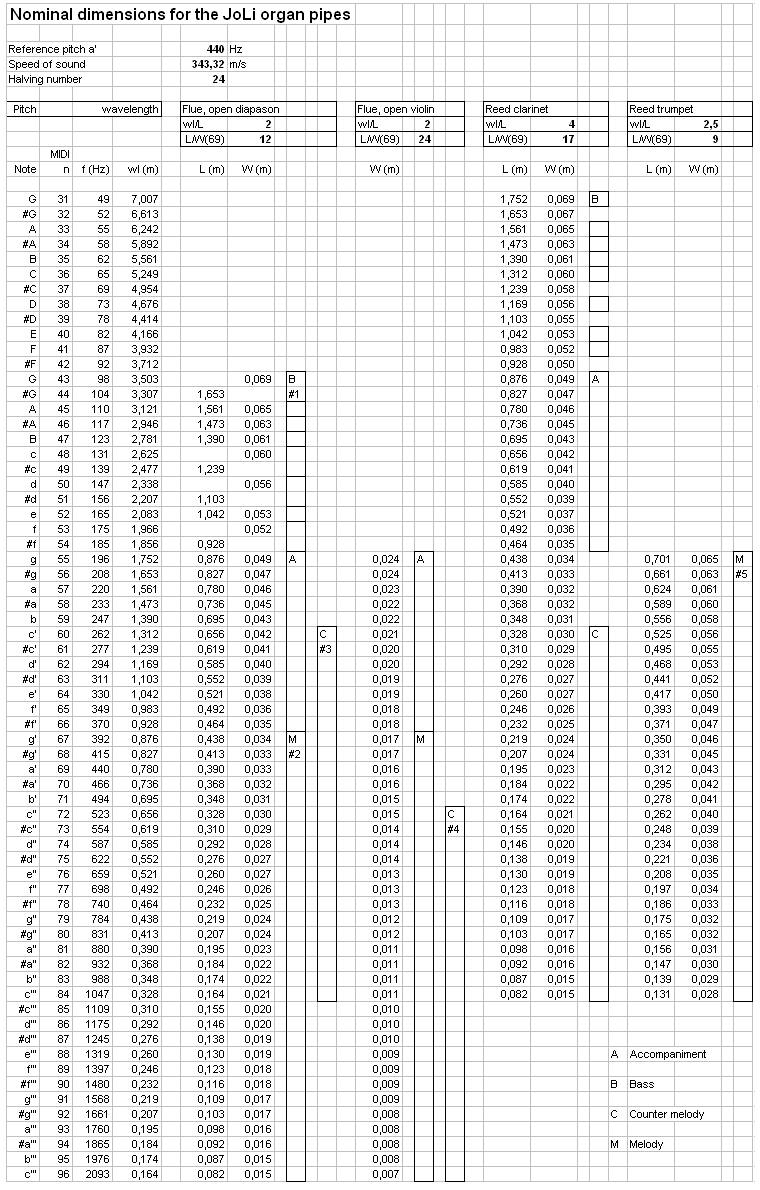 |
The length dimensions stated are
nominal fractions of fundamental wavelength. Because of the end
correction the physical length of the tuned resonators are shorter than
this by about 2W for open pipes, by W for stoppered and reed pipes. The
total
pipe external length is greater, to include pipe foot/boot and material
adjacent to the top tuning device.
|
Note #1: Four of the bass flue
pipes have detuners to enable them to generate either of two adjacent
semitones.
|
Note #2: The melody chest
additionally holds a rank of stoppered pipes with the same key
dimensions as its open flute rank, but thus speaking one octave lower.
|
Note #3: The counter melody
flutes are 1.3 times deeper than the stated width W
|
Note #4: The counter melody
violins are identically the same design as the melody violins.
|
Note #5: The melody trumpets are
flared horns with a mouth area about 20 times larger
than the throat area. The stated width W is that of the square mouth
opening.
|
JLs
05-07-31






 This is a set of
narrow
violin-type pipes that are a continuation downward from the melody
violins. The design is shown at the section of the countermelody
violins,
This is a set of
narrow
violin-type pipes that are a continuation downward from the melody
violins. The design is shown at the section of the countermelody
violins, 



 The
inner surface of the bridges is intuitively streamline shaped. The
chamfering of the covers is essential to let air be entrained with the
jet. The sound from these pipes is amazingly loud and penetrating,
regarding the minute size of the openings in the mouth region.
The
inner surface of the bridges is intuitively streamline shaped. The
chamfering of the covers is essential to let air be entrained with the
jet. The sound from these pipes is amazingly loud and penetrating,
regarding the minute size of the openings in the mouth region.


 The
horns were glued with plain white glue to give enough time to
adjust the pieces accurately while clamping. The positioning and
clamping of the four horn pieces is critical. I found the special jig
visible beside to be indispensable for the task. It is two square
angles that are adjustably held together by screws with wing nuts.
Before the gluing operation they are set to contain a rectangle
matching the horn about 1/12 of its length from the mouth. When glue
has been applied to the shoulders of the trapezoidal pieces you
assemble the four pieces in your hand, let on the squares jig, and
clamp the throat temporarily. Then you have to press the jig firmly in
direction toward the mouth. Once the jig is in place you can clamp the
rest of the
horn easily, observing to push the side pieces all the way onto the
shoulders.
The
horns were glued with plain white glue to give enough time to
adjust the pieces accurately while clamping. The positioning and
clamping of the four horn pieces is critical. I found the special jig
visible beside to be indispensable for the task. It is two square
angles that are adjustably held together by screws with wing nuts.
Before the gluing operation they are set to contain a rectangle
matching the horn about 1/12 of its length from the mouth. When glue
has been applied to the shoulders of the trapezoidal pieces you
assemble the four pieces in your hand, let on the squares jig, and
clamp the throat temporarily. Then you have to press the jig firmly in
direction toward the mouth. Once the jig is in place you can clamp the
rest of the
horn easily, observing to push the side pieces all the way onto the
shoulders.

